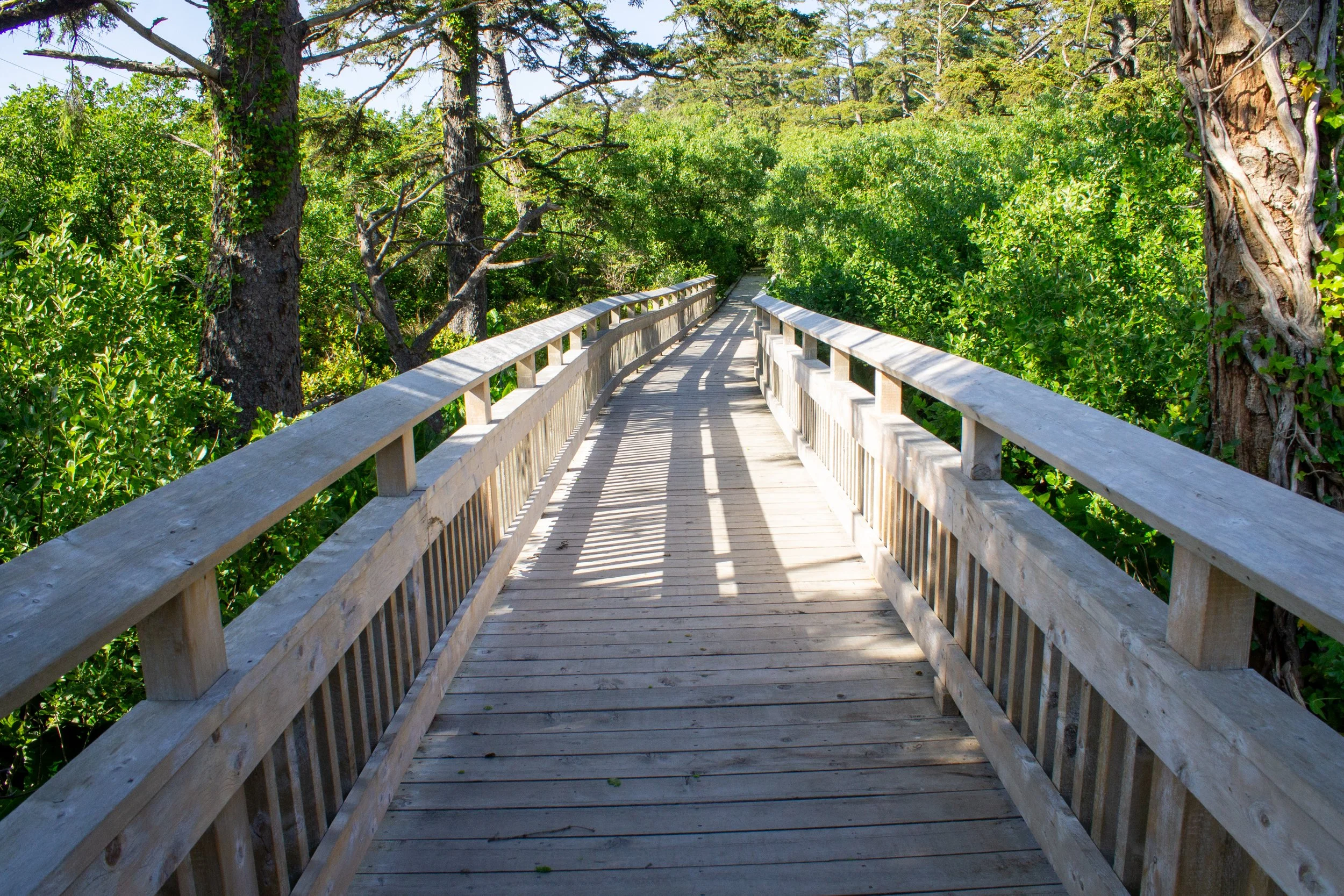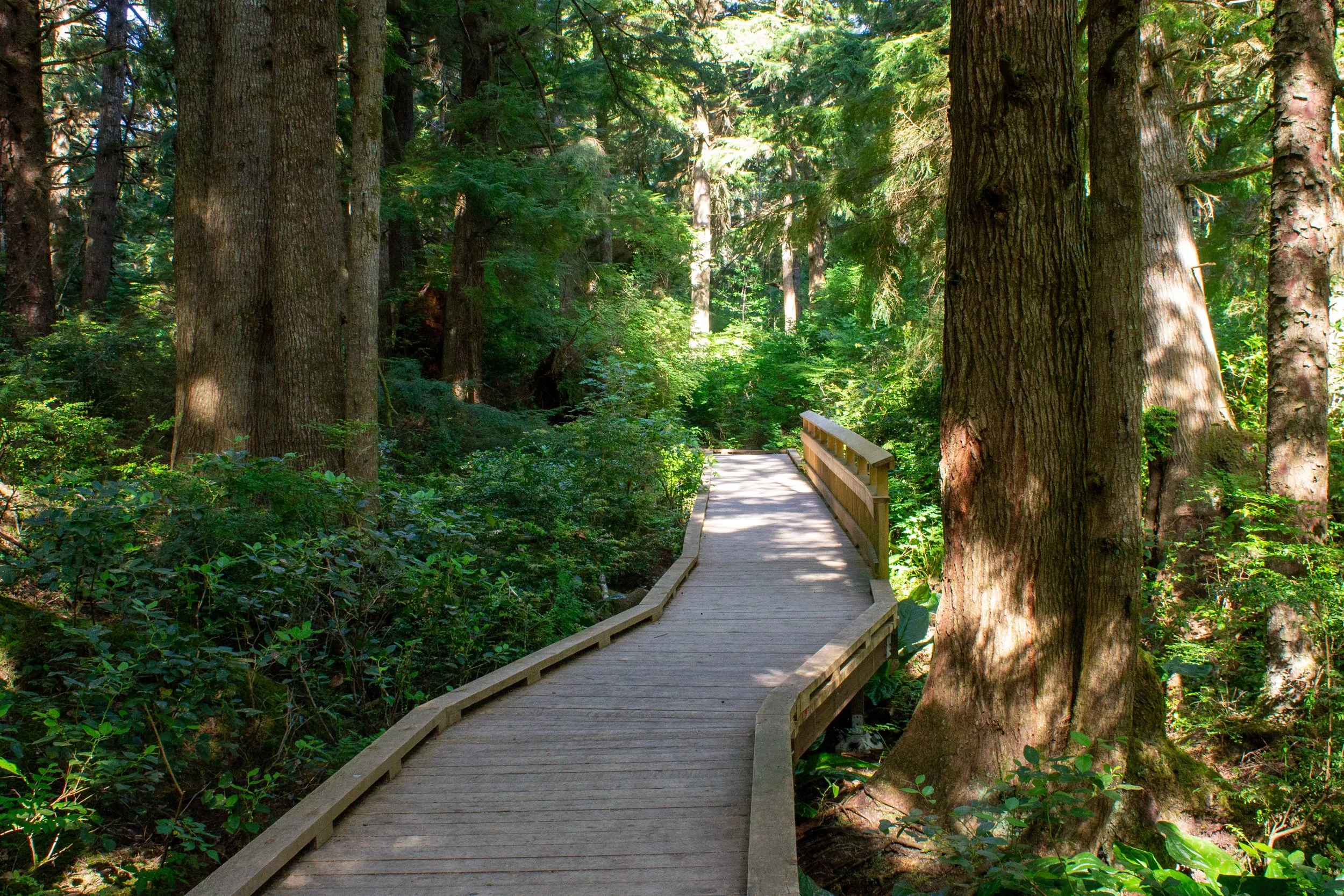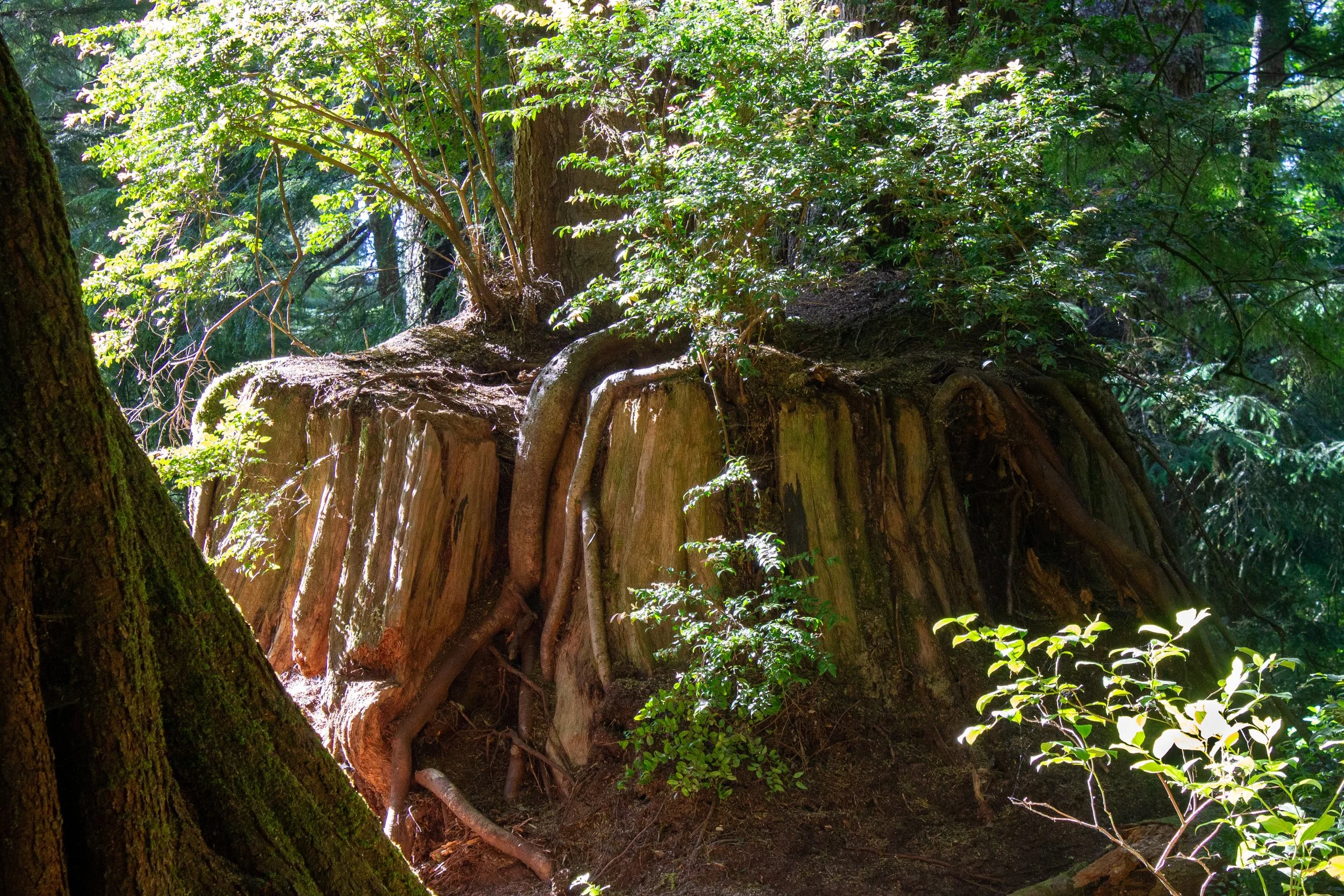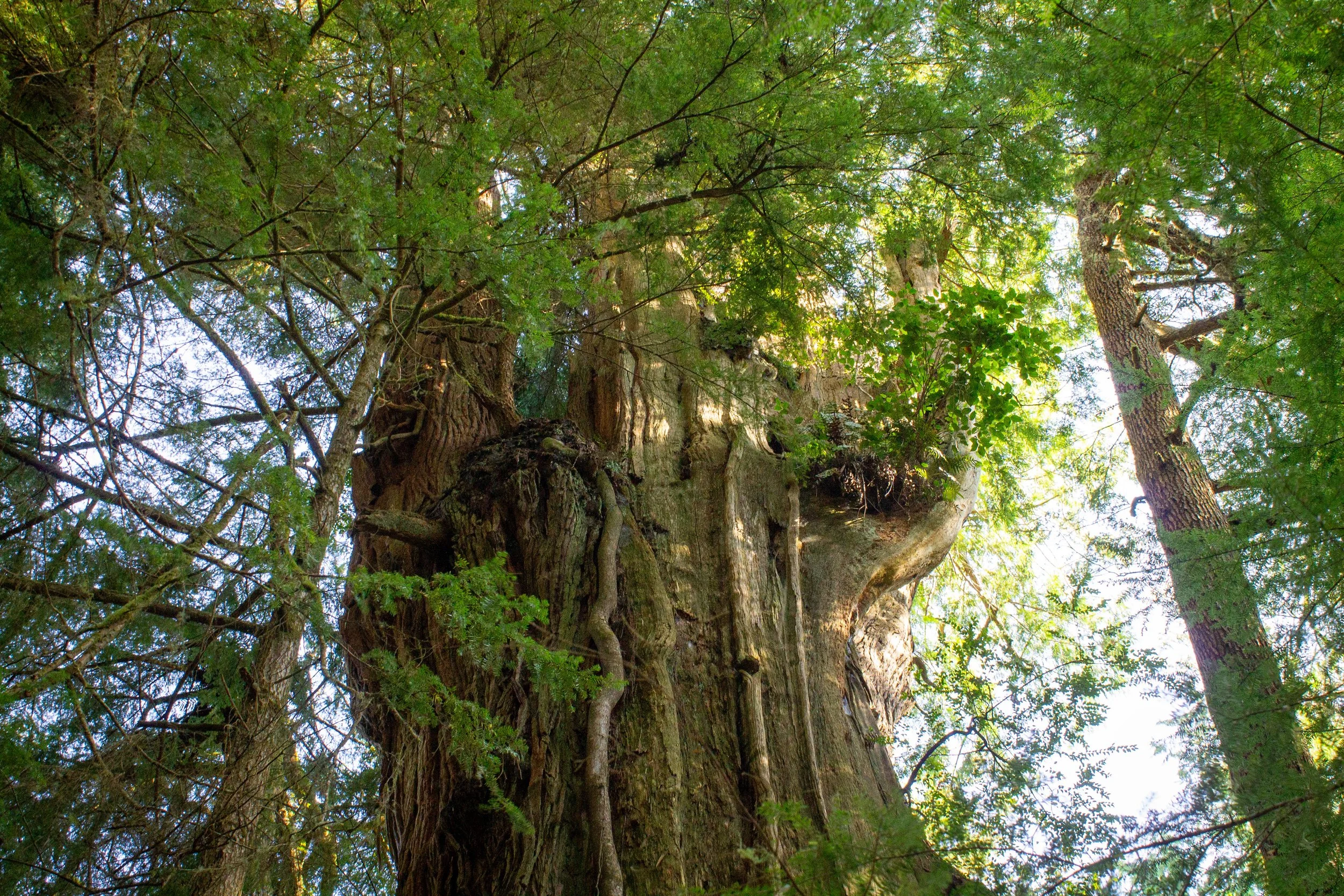Big Tree Trail in Rockaway Beach
Rockaway Beach, Oregon, is famous for its miles of beautiful sandy beaches and its curiously-shaped sea stacks. Less well-known is the Rockaway Beach Old Growth Cedar Preserve, a 46-acre nature preserve full of boggy wetlands and an ancient forest with some truly gargantuan trees. An easy boardwalk trail explores the preserve and leads to its star, the venerable western red cedar known as the Rockaway Big Tree. Come for the beach and stay for the forest. Here is everything you need to know about hiking the Rockaway Big Tree Trail.
The Big Tree Trail is a well-maintained boardwalk
Know before you go
Parking is free at the Rockaway Big Tree Trailhead. You don’t need a pass or permit.
The parking lot for the trailhead is small, but the trail is not as well-known as many hikes on the Oregon Coast and usually isn’t crowded.
Leashed dogs are welcome on the trail.
There is a port-a-potty in the parking lot.
The Big Tree Trail is a boardwalk. It is flat and even throughout the trail without steep grades or steps.
There are picnic tables at the end of a short spur trail about halfway through the hike.
The Big Tree Trail is great for families and would be no problem with a stroller.
An observation deck surrounds the Big Tree
The Big Tree Trail
Distance: 1.2 miles out and back
Elevation gain: Minimal
Difficulty: Easy
Pass required: None
Dog friendly: Yes, leashed dogs are welcome on the trails.
ADA access: Very good. The trail is a flat, even boardwalk from start to finish.
Basic directions: Follow the boardwalk trail until you reach the one and only trail junction. Take a right to reach the Big Tree, then turn around when you are ready to head back. It will look like the trail keeps going but it quickly becomes blocked by fallen trees. Once you’re back at the trail junction, turn right and follow the sign for the viewing platform. Return to the parking lot after seeing the viewing platform.
Big Tree Trailhead
The details
From the parking lot, head to the boardwalk to begin the trail. This beautiful yellow cedar boardwalk is a new feature on the coast. It was constructed both to protect the environment in the nature preserve and to create barrier-free access for hikers of all abilities. The boardwalk extends throughout the entire length of the hike and then forms an observation deck around the Big Tree to protect its root system. Expect unusually luxurious trail conditions on this hike. There are no warped or missing boards, stairs, or tree roots to negotiate. Boardwalk sections that were damaged in a windstorm earlier this year have been repaired.
Salal blooms along the Big Tree Trail
The trail begins in the wetlands of the Saltair Creek Swamp. You’ll see unbelievably massive skunk cabbage growing in the marsh, the largest I’ve seen anywhere. In early spring, look for their large yellow leaf-like flowers. You may also see pale pink salal and bright pink salmonberry blossoms on the dense bushes that line the trail. These flowers extend later into spring than the early-blooming skunk cabbage.
The only trail junction on the Big Tree Trail
You’ll soon reach the only trail junction, which is marked with a sign. Turning left will bring down a short spur trail that ends at the Viewing Platform with several picnic tables. Turning right will continue the trail out to the Big Tree. There is a small brown sign pointing to an unpaved hiking trail just before you reach the boardwalk trail junction. Go ahead and skip this unpaved trail. It is covered with fallen tree trunks and goes to the same place as the boardwalk trail.
After the trail junction, the hike enters the woods
After taking a right at the junction, the trail will become more forested. Sitka spruce, western red cedar, and red alder make up most of the canopy. You’ll see some enormous tree stumps here, including a few with new trees sprouting from them.
Nursery stump
After rounding a corner, you’ll see the star of the show, the 154-foot tall western red cedar known as the Big Tree, or sometimes, the Big Cedar. According to the sign at its base, the Big Tree is between 800 and 1,200 years old. It has survived violent coastal storms and, most likely, the earthquake and tsunami that impacted the coast around 300 years ago.
The Big Tree and its observation deck
At least as striking as the Big Tree’s height and 50-foot diameter is the knobby, gnarly appearance of its trunk. It’s worth making a circle around the observation deck at the base of the tree to appreciate its texture from all angles. There are benches and a picnic table here perfect for taking a moment to admire the Big Tree and listen to the bird songs. Look for birds like Steller’s Jays, woodpeckers, and finches in the trees and chipmunks on the ground.
The Big Tree
You’ll see the start of an unpaved hiking trail from the observation deck. This trail once made the hike into a lollipop loop by connecting back to the trail junction. It is now overgrown, unmaintained, and covered with fallen trees, some of which are quite large. Although it is possible to get back to the trail junction this way, it is much more pleasant to return the way you came.
Skunk cabbage
After admiring the Big Tree, head back to the trail junction and make a short detour (about 0.1 miles) to the viewing platform. The platform overlooks the Saltair Creek Swamp and its giant skunk cabbage. Although the viewing here is not very different from the trail through the wetlands, there are several picnic tables here that are great for having a snack, watching for birds, and taking in the greenery.
Steller’s Jay perches in the canopy
When you’re ready to go, head back to the trail junction and take a right to return to the parking lot.
Rockaway Beach
Rockaway Beach
Although the Rockaway Big Tree Trail does not have direct access to the beach, it’s only a hop, skip, and a jump away to reach the 7 miles of sand and waves on the other side of Highway 101. Rockaway Beach is unmistakable among Oregon Coast beaches because of its distinctive basaltic sea stacks known as the Twin Rocks. One of the Twin Rocks is a solid stack and the other has been eroded underneath to form an arch, giving the rocks the appearance of a sea monster rising out of the ocean waves several hundred feet offshore.
Twin Rocks
Rockaway Beach is quieter and less developed than nearby Cannon Beach to the north but still has the feeling of a beach town. The long sandy beach here tends to be uncrowded with lots of room for long walks or kite flying. One of the more unique attractions in town is a railroad with an old-fashioned steam locomotive that runs between Rockaway Beach and the neighboring town of Garibaldi during summer.
Getting there
Look for this sign to find the parking lot from Highway 101
To the Big Tree Trailhead:
The parking lot for the Big Tree Trailhead is right off Highway 101 in Rockaway Beach, Oregon. It is not hard to reach but is easy to drive by without noticing. Look for a sign for the Old Growth Cedar Trail on the east side of the highway. The drive from Portland takes a little under 2 hours.
Rockaway Beach
To Rockaway Beach:
Rockaway Beach has 20 different beach access points, about 10 of which have designated parking lots. The closest access point to the Twin Rocks is at the end of Minnehaha St. Look for a small parking lot on the corner of Minnehaha St and S Breaker Ave. The largest and most conspicuous parking lot is between Highway 101 and S Pacific St near the Rockaway Beach Chamber of Commerce. For all beach access options, look here.
Enjoy your trip to Rockaway Beach and the Big Tree Trail!
With love,
Emma
Explore nearby
Heading south, explore Tunnel Beach and the area around Oceanside.
Reference
Lund, Ernest H. "Coastal Landforms between Tillamook Bay and the Columbia River, Oregon." State of Oregon Dept of Geology and Mineral Industries, Vol. 34, No. 11, Nov 1972.




















